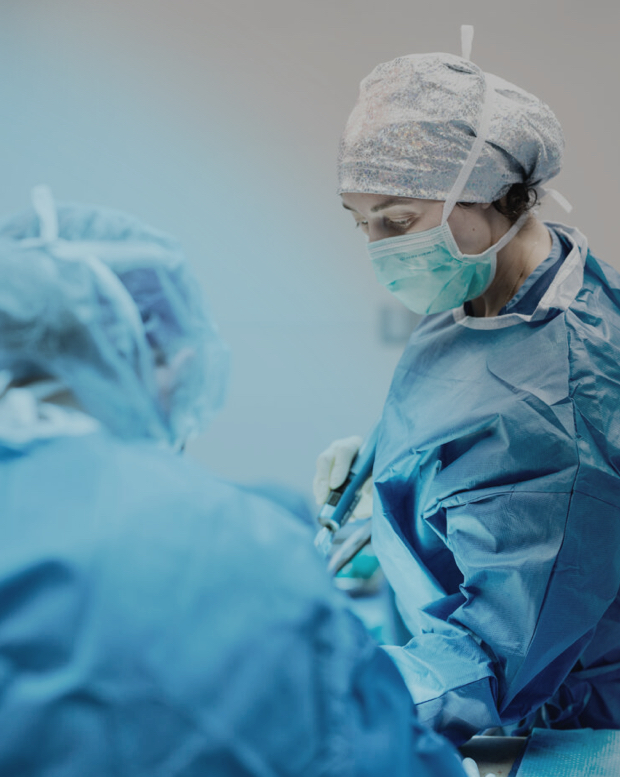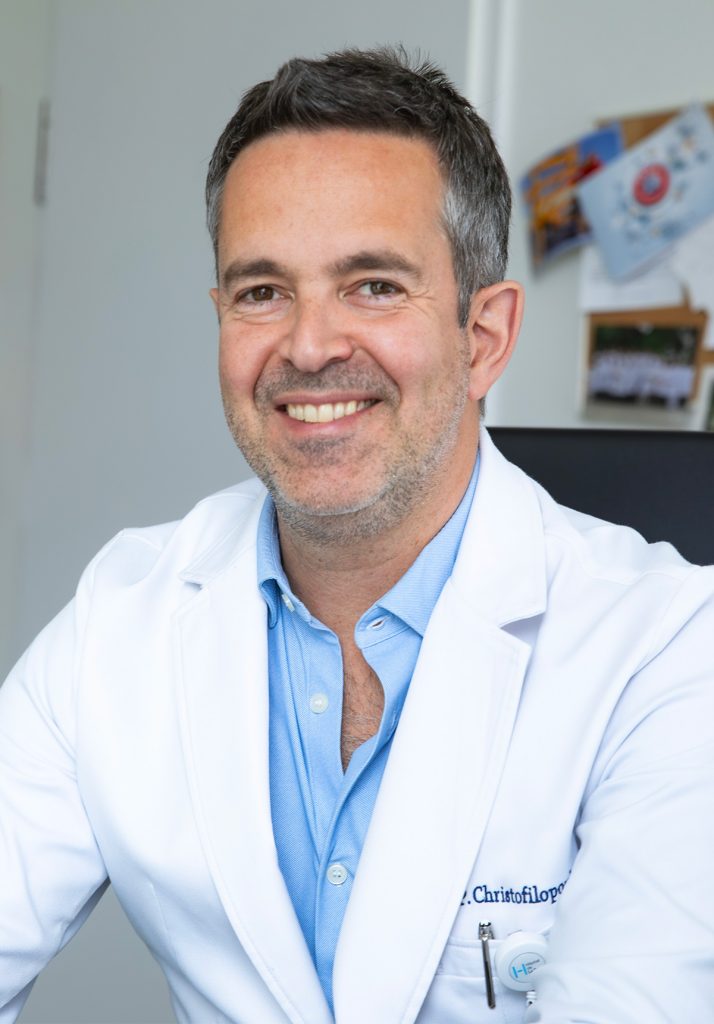CENTRE OF EXCELLENCE
Caring for you, as we would for ourselves


We take a personalised approach to your care to offer you the excellence that you and your loved ones deserve, at all times and in all circumstances.
Hôpital de La Tour has a veritable campus where numerous specialists work together. Our patients therefore benefit from multidisciplinary, comprehensive care and personalised support, from diagnosis to treatment and follow-up.
Over the years, Hôpital de La Tour has been recognised for its excellence in healthcare and is ranked among the best hospitals based on various factors, including patient outcomes, medical reputation and patient satisfaction.
Our team of surgeons, who are highly specialised in the treatment of hip conditions, can drastically reduce the operating time required for prosthesis implantation, a recognised risk factor for infection.
As part of our value-based healthcare strategy, we systematically evaluate the impact of treatments on our patients’ daily lives and care pathways. This information helps us to continuously adjust care protocols, keep healthcare professionals up to date in their respective specialities and, ultimately, improve the quality of care we provide to our patients.
Our multidisciplinary team practises highly specialised medicine. All of its members are hip experts who devote all their time to this joint, constantly increasing their expertise in the field.
Specialist in orthopaedic surgery and traumatology of the musculoskeletal system, member of the FMH; hip and pelvic surgery
Specialist in orthopaedic surgery and traumatology of the musculoskeletal system, member of the FMH
We diagnose and treat various hip and pelvic conditions. The most common pathologies we treat and their possible treatments are:

Symptoms of CFA include deep or stabbing pain in the groin area, often radiating to the thigh or knee. Loss of joint mobility, particularly in flexion and rotation, is common, sometimes accompanied by cracking. Diagnosis is based on a clinical examination and specific radiological tests to confirm the condition.
Treatment initially favours a conservative approach: rest, adaptation of sporting activities, physiotherapy, and anti-inflammatory drugs. If symptoms persist, surgery, usually arthroscopy, may be considered to correct morphological abnormalities, with a good success rate and a rapid return to sporting activities.
At Hôpital de La Tour, treatment includes a complete clinical examination followed by radiological tests to confirm the diagnosis. If surgery is necessary, arthroscopy is preferred for its effectiveness. Rapid post-operative rehabilitation is implemented to allow a gradual return to physical activity.

During the medical examination, the doctor begins by physically examining the joint to assess pain, swelling, redness and mobility. They then usually prescribe an X-ray, which reveals the narrowing of the joint space and bone spurs. In complex cases, an MRI scan, blood tests or joint fluid analysis may be performed.
Relief from hip osteoarthritis begins with simple everyday solutions. During flare-ups, painkillers or anti-inflammatory drugs, or even corticosteroid injections, may be prescribed. Although there is no cure for osteoarthritis, these approaches can slow its progression and delay the need for surgery. When pain and loss of mobility become too debilitating, hip replacement surgery is often necessary. This procedure offers excellent results in over 90% of patients, generally allowing them to return to a near-normal life.

Hip dysplasia
Gluteal muscle disorders
Problems with existing prostheses (implant loosening, wear and tear, chronic infection)
Tendon problems around the hip (tendon rupture, chronic tendinitis)
We also treat hip and pelvic trauma with surgical or conservative treatments depending on the injury.
If surgery is the chosen option, a fully personalised care pathway will be put in place by a specially trained team, based on the health condition of each of our patients. It will be coordinated around their well-being.
The patient’s health progress, their recovery, and listening to their needs and those of their loved ones are all carefully taken into account throughout your care pathway at Hôpital de La Tour. Indeed, restoring your quality of life is our priority.
Thanks to a care pathway that begins before the operation, our patients arrive prepared, reassured and relaxed on the day of their surgery. They also benefit from post-operative follow-up for as long as necessary, which is another factor contributing to their well-being.
Review with the sports doctor and surgeon of the various treatment options
Preoperative review and consultation with the surgeon and anaesthetist
Preoperative class on the surgery and rehabilitation (to reduce apprehension about the surgery and improve the hospital stay) and simulation of exercises with walking sticks
Pre-operative assessment
Preventive screening for infections
Surgery by an expert hip surgeon
Pain management
Immediate mobilisation session: our patients get up 4 hours after the operation and climb stairs the next day.
2 physiotherapy sessions every day throughout their stay (2 to 5 days)
Stay in a private room or suite in a care unit where all staff are specialised in the treatment of hip conditions
À la carte meals
9 hydrotherapy sessions + approximately 9 rehabilitation sessions
Medical follow-up 8, 15 and 30 days after surgery
Monitoring of your quality of life in the medium and long term with health questionnaires

Take our virtual tour to explore our facilities in an interactive and immersive way.
Découvrez notre visite virtuelle pour explorer nos locaux
de manière interactive et immersive.
Distinction
L’Hôpital de La Tour ranked among the world’s best hospitals for orthopaedics in the annual study conducted by Newsweek magazine
Hôpital de La Tour strives every day to achieve the highest standards of medical excellence. Measured medical performance, combined with research within the institution itself, are at the heart of this quest for continuous improvement.
Hôpital de La Tour is one of Switzerland’s pioneering healthcare institutions and a global leader in the implementation of a value-based healthcare system, more commonly known as VBHC (Value Based Health Care).
Thanks to the strong bond of trust established with our patients and with their consent, the Hip Centre collects data on their quality of life following surgery. This collaboration enables us to measure medical outcomes, which guarantees a high level of care and continuous improvement in treatment.
The specialists who treat hip conditions are recognised trainers in Switzerland and train the next generation of professionals. This has earned Hôpital de La Tour the accreditation ‘ISFM Training Centre in Orthopaedics, Category B’. This training campus on the hospital site enables us to continuously improve excellence, reduce risks and optimise results.








Coxarthrosis, also known as hip osteoarthritis, is a degeneration of the cartilage in the hip joint, which connects the thigh bone to the pelvis. This wear and tear on the cartilage causes the bones to rub together, leading to pain, joint stiffness and loss of mobility. Coxarthrosis is a chronic disease that progresses slowly over time and can become debilitating.
Although coxarthrosis is often associated with ageing, it can be diagnosed in people under the age of 40. However, the prevalence of this condition increases significantly after the age of 50 and affects women more frequently, particularly after the menopause due to the decrease in hormonal protection (oestrogen).
A hip replacement is recommended when conservative treatments (medication, physiotherapy, injections) become ineffective in treating osteoarthritis, femoral neck fractures before the age of 80, rheumatoid arthritis or femoral osteonecrosis. The procedure is justified by persistent severe pain, debilitating stiffness and muscle wasting.
Femoroacetabular impingement (FAI) is abnormal contact in the hip joint, mainly due to a morphological abnormality of the femoral neck. This disorder is characterised by bony growths on the femoral head and/or acetabulum, which cause friction and prevent the bones from sliding naturally during hip movements.
Femoroacetabular impingement is mainly characterised by deep pain localised in the groin. Patients also report a feeling of stiffness in the hip, accompanied by reduced mobility. The movements particularly affected are flexion and rotation of the joint. In some cases, the pain can radiate to the thigh and down to the knee.